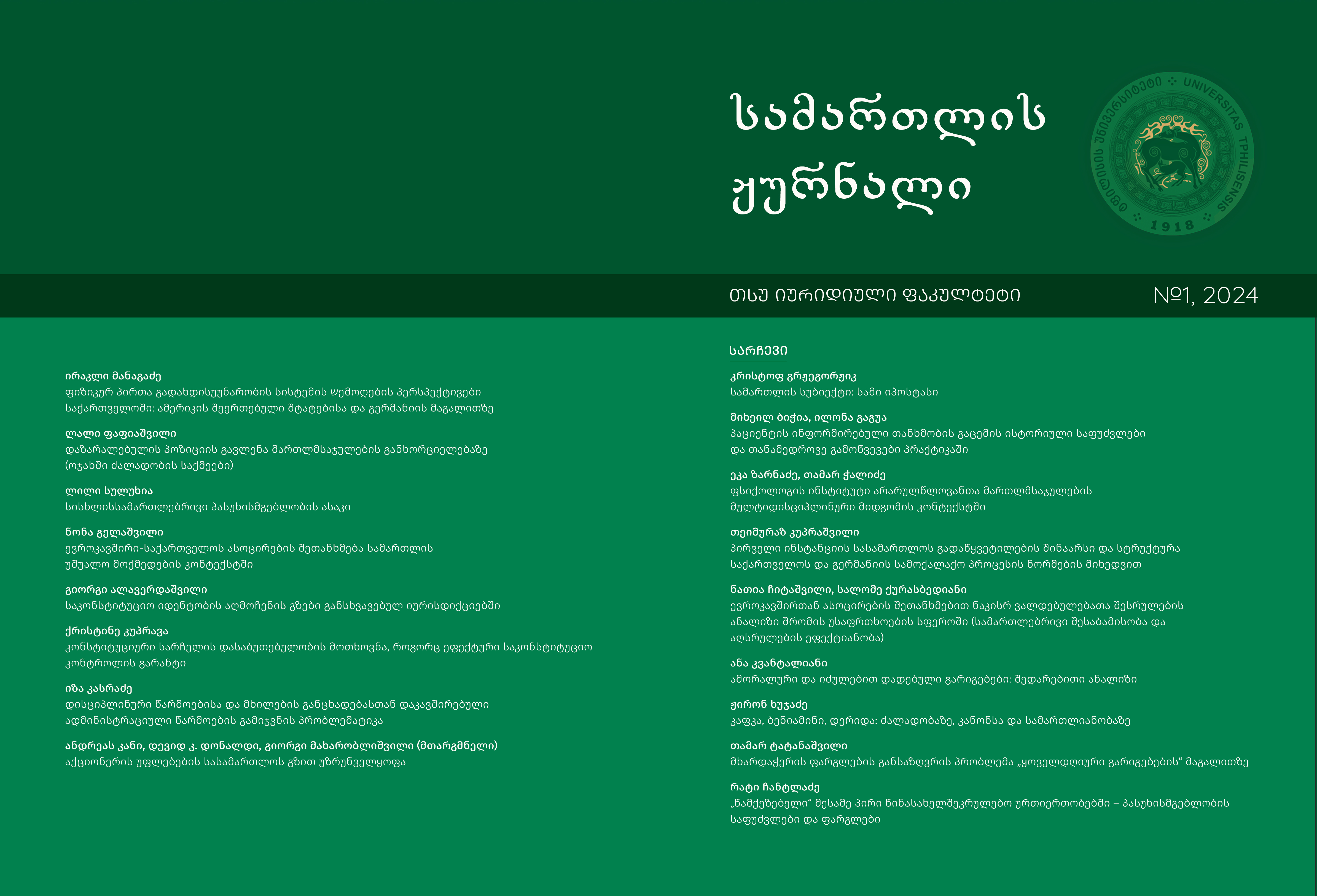Unpacking U.S. and German Individual Bankruptcy Systems: Insights and Recommendations for Georgia
DOI:
https://doi.org/10.60131/jlaw.1.2024.7953Keywords:
Bankruptcy Stigma, Consumer Insolvency, Discharge, “Fresh-start”, Individual Bankruptcy, Liquidation, Second Chance.Abstract
I want to thank Professor Tibor Tajti (Central European University) for his invaluable guidance and support during my research. Also, I extend my appreciation to Emeritus Professor Reinhard Bork (Hamburg University) for his insights into the German consumer insolvency system.
The article addresses the absence of individual bankruptcy law in Georgia, despite the growing need arising from increased credit accessibility and subsequent default rates. The central research question revolves around an in-depth examination of individual bankruptcy frameworks in the United States (U.S.) and Germany. Drawing from these jurisdictions, this article offers recommendations to inform Georgian lawmakers on key policies, regulations, and features to consider when instituting provisions for individual bankruptcy.
Furthermore, insights gained from an interview with Emeritus Professor Reinhard Bork, a distinguished authority on German insolvency law, enrich the discourse on the practical issues of the German consumer insolvency system.
References
U.S. Constitution (17/09/1787).
U.S. Code: Title 11 (06/11/1978).
Insolvenzordnung – InsO (German Insolvency Code), Federal Law Gazette I, p. 2866, 5/10/1995.
Constitution of Georgia, Departments of the Parliament, 31-33, 24/08/1995.
Law of Georgia on Rehabilitation and the Collective Satisfaction of Creditors’ Claims, 25/09/2020.
Law of Georgia on Enforcement Proceedings, LHG, 13(20), 01/05/1999.
Law of Georgia on Insolvency Proceedings, LHG, 9, 31/03/2007 (annulled 01.04.2021).
Law of Georgia on Bankruptcy Proceedings, Parliamentary Gazette, 19-20, 30/07/1996 (annulled 15.08.2007).
Aberasturi J., Trouble with BAPCPA: A Call for Statutory Reform regarding Retirement Contributions in Chapter 13 Bankruptcy Plans, American Bankruptcy Institute Law Review, Vol. 30, №2, 2022, 280-82.
Adler B.E., Baird D.G., Jackson T. H., Bankruptcy: Cases, Problems and Materials, 4th ed., New York, 2007, 560.
Baird D. G., The Elements of Bankruptcy, 5th ed., New-York, 2010, 30.
Bork R., Corporate Insolvency Law: A Comparative Textbook, Cambridge/Antwerp/Chicago, 2020, 191, 194-98, 200-01, 204, 207.
Braun S., German Insolvency Act: Special Provisions of Consumer Insolvency Proceedings and the Discharge of Residual Debts, German Law Journal, Vol. 7, №6, 2006, 61.
Braun, German Insolvency Code: Article-by-Article Commentary, 2nd ed., Munich, 2019, 779-81, 783, 785, 793.
Byington J. S., The Fresh Start Canon, Florida Law Review, Vol. 69, №1, 2017, 116, 120-21.
Carlson D. G., Philosophy in Bankruptcy, Michigan Law Review, Vol. 85, Issue 5 & 6, 1987, 1365.
Czarnetzky J. M., The Individual and Failure: A Theory of the Bankruptcy Discharge, Arizona State Law Journal, Vol. 32, №2, 2000, 394, 396, 399, 464.
Epstein D. G. and others, Bankruptcy: Dealing with Financial Failure for Individuals and Businesses, 4th ed., St. Paul, 2015, 165, 237, 243.
Epstein D. G., Bankruptcy and Related Laws in a Nutshell, 9th ed., St. Paul, 2017, 49-50, 243, 246, 255-56, 273-75, 348-49.
Er M., The German Consumer Bankruptcy Law and Moral Hazard – The Case of Indebted Immigrants, Journal of Financial Regulation and Compliance, Vol.28, №2, 2020, 161-62, 166-67, 177.
Ferguson N., The Ascent of Money: A Financial History of the World, New York, 2009, 60.
Fisher J. D., Who Files for Personal Bankruptcy in the United States?, The Journal of Consumer Affairs, Vol. 53, №4, 2019, 2005.
Fossen F.M., Personal Bankruptcy Law, Wealth, and Entrepreneurship—Evidence from the Introduction of a "Fresh Start" Policy, American Law and Economics Review, Vol. 16, №1, 2014, 273.
Greene S. S., The Failed Reform: Congressional Crackdown on Repeat Chapter 13 Bankruptcy Filers, American Bankruptcy Law Journal, Vol. 89, №2, 2015, 242.
Gvelebiani J., Kochlashvili A., Amisulashvili N., Feasibility Study: On the Regulation of Personal Insolvency, Tbilisi, 2021, 13, 15-20, 38, 40-41, 46, 55, 71, 76.
Hynes R. M., Lawton A. & Howard M., National Study of Individual Chapter 11 Bankruptcies, American Bankruptcy Institute Law Review, Vol. 25, №1, 2017, 66, 164.
Jackson T.H., The Logic and Limits of Bankruptcy Law, Washington D.C., 2001, 225, 233-36, 245.
Jimenez D., The Distribution of Assets in Consumer Chapter 7 Bankruptcy Cases, American Bankruptcy Law Journal, Vol. 83, №4, 2009, 800.
Jones D. R., Savings: The Missing Element in Chapter 13 Bankruptcy Cases, American Bankruptcy Institute Law Review, Vol. 26, №2, 2018, 244, 245-46, 250, 253.
Keith C. A., A Forced Crisis: Why Student Loan Debt Should Be Separately Classified under Chapter 13 Bankruptcy Plans, Delaware Journal of Corporate Law, Vol. 44, №2-3, 2020, 253, 255.
Clarkson K. W. and others, Business Law: Text and Cases, 11th ed, Maison (U.S.), 2009, 612, 614, 621.
Kischel U., Comparative Law, Oxford, 2019, 359-60.
McDonald G. K., Homelessness in the COVID Era: Utilizing the Bankruptcy Solution, Yale Law & Policy Review, Vol. 41, №1, 2022, 150.
Michael T. L., There's a Storm a Brewin': The Ethics and Realities of Paying Debtors' Counsel in Consumer Chapter 7 Bankruptcy Cases and the Need for Reform, American Bankruptcy Law Journal, Vol. 94, №3, 2020, 389.
Ramsay I., Personal Insolvency in the 21st Century, Oxford and Portland, 2017, 37, 41-42.
Ramsay I., U.S. Exceptionalism, Historical Institutionalism, and the Comparative Study of Consumer Bankruptcy Law, Temple Law Review, Vol. 87, №4, 2015, 969.
Sepinuck S. L., Duhl G. M., Problems and Materials on Bankruptcy Law and Practice, 3rd ed., St. Paul, 2017, 28, 30, 45-46, 137.
Sousa M.D., The Principle of Consumer Utility: A Contemporary Theory of the Bankruptcy Discharge, University of Kansas Law Review, Vol. 58, №10, 2010, 562-63, 585, 587-89, 594.
Spurr S. J. & Ball K. M., The Effects of a Statute (BAPCPA) Designed to Make It More Difficult for People to File for Bankruptcy, American Bankruptcy Law Journal, Vol. 87, №1, 2013, 30-31.
Sullivan T. A., Warren E. & Westbrook J. L., Less Stigma or More Financial Distress: An Empirical Analysis of the Extraordinary Increase in Bankruptcy Filings, Stanford Law Review, Vol. 59, Issue 2, 2006, 233.
Tabb C. J., Brubaker R., Bankruptcy Law: Principles, Policies, Practice, 1st ed., U.S., 2003, 57-58.
Tabb C. J., Law of Bankruptcy, 5th ed., St. Paul, 2020, 39, 41, 47-48, 50, 88-92, 98-103, 128, 168-169, 172, 946, 949-52, 967, 970, 979, 985, 990-92, 999, 1208, 1216, 1219, 1221, 1228-29, 1263.
Tabb C. J., The Death of Consumer Bankruptcy in the United States, Bankruptcy Developments Journal, Vol. 18, №1, 2001, 10.
Tabb C. J., The Top Twenty Issues in the History of Consumer Bankruptcy, University of Illinois Law Review, Vol. 2007, №1, 2007, 29.
Tajti T., Bankruptcy Stigma and the Second Chance Policy: The Impact of Bankruptcy Stigma on Business Restructurings in China, Europe and the United States, China-EU Law Journal, Vol. 6, Issue 1-2, 2018, 8, 12, 15, 16, 26.
Taylor A. N. & Sheffner D. J., Oh, What a Relief It (Sometimes) Is: An Analysis of Chapter 7 Bankruptcy Petitions to Discharge Student Loans, Stanford Law & Policy Review, Vol. 27, №2, 2016, 303.
Wang J. and others, Bankruptcy and the COVID-19 Crisis, Harvard Business School, Working Paper 21-042, September 2020, 1-5.
Zywicki T. J., Bankruptcy Law as Social Legislation, Texas Review of Law & Politics, Vol. 5, №2, 2001, 394, 398, 429.
Meskhishvili K. and others, Basics of Insolvency Proceedings According to the Law of Georgia on Rehabilitation and the Collective Satisfaction of Creditors’ Claims, Tbilisi, 2021, 27 (in Georgian).
World Bank (2013) Insolvency and Creditor/Debtor Regimes Task Force, Report on the Treatment of the Insolvency of Natural Persons, 42.
Interview with Reinhard Bork, Emeritus Professor, Faculty of Law, Hamburg University (Hamburg, Germany, 21 March 2023).
In re Mosley, 494 F.3d 1320 (11th Cir. 2007).
Hebbring v. Trustee, 463 F.3d 902 (9th Cir. 2006).
Brunner v. N.Y. State Higher Educ. Servs. Corp. - 831 F.2d 395 (2d Cir. 1987).
Local Loan Co. v. Hunt, 292 U.S. 234, 244 (1934).
Decision of August 27, 2009, N1/2/434 of the Constitutional Court of Georgia, Dissenting opinion of Ketevan Eremadze and Besarion Zoidze (paragraph 9), (in Georgian).
< https://bm.ge/en/article/gadaxdisuunaroba-shesadzloa-fizikur-pirebzec-gavrceldes/15059 > [13.06.2023] (in Georgian).
<http://www.barristers.ge/ge/page/news_item/1388?fbclid=IwAR2moLlT0Y35U7VXBHJ6IjX_1X-Lw-GEjEWtY99HYbdSIFWbuJ95TK4GzGU > [15.06.2023] (in Georgian).
< https://www.congress.gov/bill/117th-congress/senate-bill/4980?s=1&r=96 > [9.06.2023].
< https://debt.reestri.gov.ge/ > [15.06.2023] (in Georgian).
< https://data.who.int/countries/268 > [13.06.2023].
< https://www.geostat.ge/en/modules/categories/322/migration >, [15.06.2023].
< https://www.justia.com/bankruptcy/exemptions/ > [3.06.2023].
< https://www.justia.com/bankruptcy/exemptions/federal-bankruptcy-exemptions/ > [3.06.2023].
< https://www.justia.com/covid-19/debts-and-bankruptcy-during-the-covid-19-outbreak/ > [15.06.2023].
< https://www.kelleylawoffice.com/consumer-bankruptcy-reform-act-of-2022-what-to-know/ > [9.06.2023].
< http://nbe.gov.ge/index.php?sec_id=367&lang_id=ENG > [15.04.2023].
< https://news.bloomberglaw.com/bankruptcy-law/consumer-bankruptcy-overhaul-envisioned-in-new-bill-explained-1 > [9.06.2023].
< https://www.uscourts.gov/services-forms/bankruptcy/bankruptcy-basics/discharge-bankruptcy-bankruptcy-basics > [20.10.2023].
Downloads
Published
How to Cite
Issue
Section
License
Copyright (c) 2024 Irakli Managadze

This work is licensed under a Creative Commons Attribution-ShareAlike 4.0 International License.









